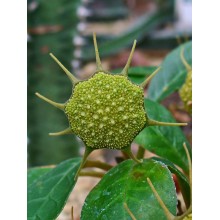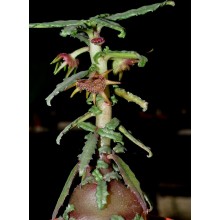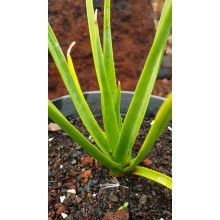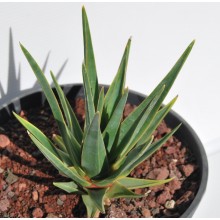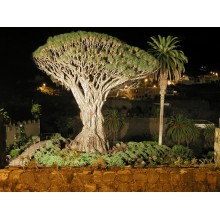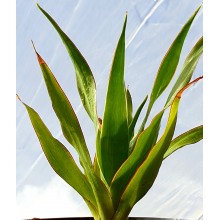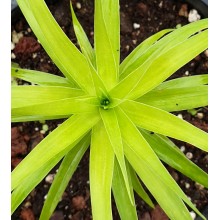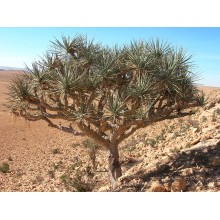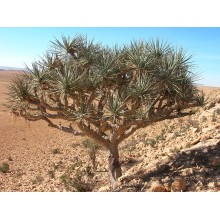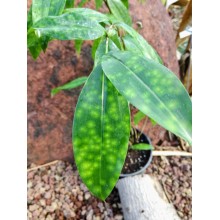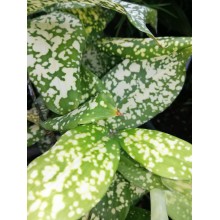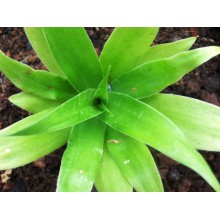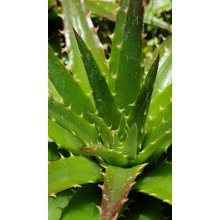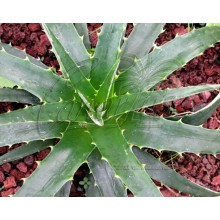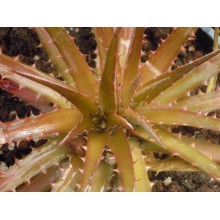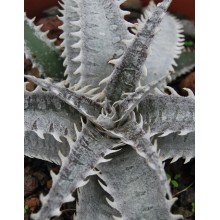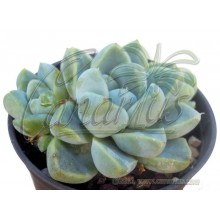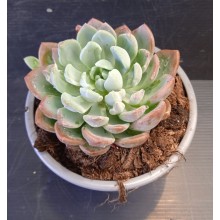Succulents There are 628 products.

World deserts and dry areas are home to the most interesting plants. Canarius offers an increasing selection of succulent plants of maximum quality, because they are grown outdoors, under the full sun of the Canary Islands.
Succulents or "fat plants" are water-retaining species, adapted to dry conditions. They store succum (juice, water) in their leaves, stems or roots, and often show a stout and fleshy appearance.
Subcategories
-
Agave
Agave is a genus of succulent plants from America. Some species grow in cold areas and take hard frost, while some others live in tropical climates. Some are tiny dwarfs and some are giants, up to 2 or 3 m wide.
Cold hardy agaves can create an exotic effect in your garden. Agave species make fine companions to palms or cacti. Variegated agaves are incredibly sought after by collectors. Our web shop offers an ever changing selection of species. We ship bare rooted plants, unless otherwise specified.
-
Aloe, Gasteria & Haworthia
Aloe, Gasteria and Haworthia are three related genera, comprising hundreds of succulent plants. They are all easily grown in pots. A few adapt to low-light levels of indoor conditions and can be grown as house plants.
- Aloe is a genus of about 400 species, native to Africa, Arabia and Madagascar. Small or dwarf aloes are becoming especially popular in colder climates as they can be taken indoors during the hardest months.
- Gasteria includes some 80 species endemic to South Africa, known for their spectacular leaves which are glossy, mottled and textured. They bloom in Spring-Summer with long spikes of small orange flowers. Some species are so variable that we offer particular clones from specific locations.
- Haworthia is a genus endemic to South Africa with about 70 species and a number of local subspecies, varieties and forms. Leaves are often banded, speckled, dotted, or semi-translucent and show wide variations.
-
Crassulaceae
This is a new, growing section of species from the family Crassulaceae. There are about 1,400 species in 33 genera and their distribution is worldwide, but mostly occur in the Northern Hemisphere and Southern Africa, especially in dry habitats. Here you can buy healthy, sun-hardened plants grown in the Canary Islands and shipped to your home.
-
Mesembs
This group of desert plants is briefly named Mesembs because they belong to a botanical family formerly named Mesembryanthemaceae. There are almost 2.000 species, mainly found in Southern Africa, with extreme adaptations to dry habitats. Some are called "living stones", as they look like pebbles. Many are easy to grow and their main need is full sun. Some are difficult because they grow in truly extreme areas.
Our Web Shop offers sun grown healthy plants, with compact and colourful leaves. Some plants are sold as cuttings, and others as rooted plants, of at least two years old.
-
Sansevieria
Recently assigned to the family Asparagaceae, the genus Sansevieria counts about 70 species, nearly all native to Africa, Arabia and Madagascar. Perennial herbs adapted to dry habitats with stiff, succulent leaves, their length ranges from a few centimeters to 2 meters. Sansevieria trifasciata and its many cultivars are among the most popular houseplants, popularly called mother in law's tongue. A well grown plant usually produces a spike of many white, richly scented flowers and then orange berries. Even the rarest species are resistant to neglect, provided you keep them from frost in winter and scorching sun in summer.
-
Hoya
Hoyas are twining vines, with showy exotic flowers, from the rainforests in Asia and Oceania. Most species grow in bright shade or morning sun, but they will also grow indoors as house plants. They are well suited for baskets, trellises or ladders. They tolerate a few weeks of drought but they are sensitive to frost and cold. Many hoyas are easy to grow and bloom, while some are tricky and rare.
-
Asclepiads
Asclepiads or Asclepiadoideae are a subfamily in the Apocynaceae, with about 2900 species. There are lots of leafless stem succulents but also perennial herbs, shrubs, lianas or rarely trees. They produce remarkable flowers, for the complex mechanisms they have developed for pollination. Many species produce an unusual fragrance, often called "carrion", and attracts flies for pollination. -
Caudiciforms
These plants from dry areas produce an unusually thick stem, the caudex. They are also called pachycauls and they have a disproportionately thick trunk, often with few branches. The caudex can be hidden underground, but in most cases they grow upwards, forming spectacular trees. The largest caudiciforms in the world are the baobabs. -
Other succulents
Here you will find all those species of desert plants that are not included in their own category. We will place here all plants from unusual families, other than Agaves, Aloes, Crassulaceae, Sansevieria, Mesembs, Epiphytic cacti, etc.
-
Dorstenia foetida
Dorstenia foetida
Dorstenia foetida is small and "palm-like" in shape. Its caudex has a green-and-grey bark nicely dotted with leaf scars. Arching leaves form a rosette on the top of the stem.
10,80 € -
Dorstenia hildebrandtii crispa
Dorstenia hildebrandtii crispa
This is the most beautiful form of the widespread Dorstenia hildebrandrii. It is cute in all its stages, with a rounded, smooth swollen base which can be green to maroon.
17,40 € -
Doryanthes palmeri
Doryanthes palmeri
The giant spear lily grows as a moncarpic rosette like an agave, but has floppy spineless leaves up to 2 or 3 m long. It will eventually bloom with a bright red flowering structure, up to 3 to 5 meters tall.
94,00 € -
Dracaena cinnabari
Dracaena cinnabari
The most extraordinary dragon tree is the one from the island of Socotra. Here we offer 3-4 years old seedlings.
83,40 € -
Dracaena cinnabari- LARGE
Dracaena cinnabari- LARGE
The most extraordinary dragon tree is the one from the island of Socotra. Here we offer 5-6 years old seedlings.
287,00 € -
Dracaena draco
Dracaena draco
h= 18-30 cm The mythical "Dragon Tree" of the Canary Islands is a tall, long-lived succulent tree.
15,00 € -
Dracaena draco ssp. ajgal
Dracaena draco ssp. ajgal
This is the new "Dragon Tree" from Morocco, discovered a few years ago in the SW Atlas mountains. It is a tall, long-lived succulent tree. It grows much like the more common Canarian subspecies, with some differences. Being an inland subspecies, it is possibly more hardy to cold!
36,00 € -
Dracaena draco ssp. caboverdeana
Dracaena draco ssp. caboverdeana
This new subspecies of the Canarian Dragon Tree was described in 2012. Its most visible difference is the blue-grey colour in the leaves.
57,20 € -
Dracaena ellenbeckiana
Dracaena ellenbeckiana
This Dracaena forms a large shrub, similar to a Yucca, branched from the base, 2-8 m tall.It is native to semi-evergreen bushland or open dry forest on rocky slopes, from Ethiopia to Uganda. It is often locally common at 1000–2100 m.
48,30 € -
Dracaena serrulata
Dracaena serrulata
12 years old, Leaf height 35-45 cm ! - This dragon tree comes from the southern escarpments of the Arabian Peninsula. It is a sparsely-branched tree, very rare and slow-growing, which can reach 5 m in very old specimens. Its stiff, sword-like leaves are densely congested at the tip of the branches.
290,00 € -
Dracaena serrulata - SMALL
Dracaena serrulata - SMALL
10 years old, Leaf height 25-35 cm ! - This dragon tree comes from the southern escarpments of the Arabian Peninsula. It is a sparsely-branched tree, very rare and slow-growing, which can reach 5 m in very old specimens. Its stiff, sword-like leaves are densely congested at the tip of the branches.
172,00 € -
Dracaena surculosa
Dracaena surculosa
This dracaena looks different from most others. It has showy mottled foliage held on thin bamboo-like stems. Also its white flowers are beautiful as they show up on sphaerical, fragrant inflorescences. It is native to the rainforest understorey of different West African countries and does well as a house plant in a bright room.
14,20 € -
Dracaena surculosa 'Florida Beauty'
Dracaena surculosa 'Florida Beauty'
This dracaena looks different from most others. It has showy mottled foliage held on thin bamboo-like stems. Also its white flowers are beautiful as they show up on sphaerical, fragrant inflorescences. It is native to the rainforest understorey of different West African countries and does well as a house plant in a bright room.
16,20 € -
Dracaena transvaalensis
Dracaena transvaalensis
Ornamental, semi-succulent dragon-tree from summer rainfall areas South Africa. It grows on rocky slopes, attaining heights of 2-6 m. It is very uncommon in cultivation! This Dracaena is relativey fast growing and can attain blooming size in les than ten years. It will thrive in Mediterranean conditions, with little or no frost.
54,60 € -
Dyckia encholirioides
Dyckia encholirioides
Glossy green, soft leaved succulent Dyckia. It is a variable species native to the coastal areas of Southern Brazil.
13,70 € 16,70 €Reduced price! -
Dyckia fosteriana rubra
Dyckia fosteriana rubra
This is a supreme clone of Dyckia fosteriana, with bronze coloured rosettes. It is a cold-resistant bromeliad from the rocky mountains of Paraná, in South Brazil.
19,50 € -
Dyckia x 'Avalanche'
Dyckia x 'Avalanche'
Showy silvery hybrid. Leaves are coated in furry trichomes, wide at the base and armed with large, white, recurved marginal spines. Highly ornamental and easy to grow!
42,00 € -
Echeveria albicans
Echeveria albicans
Cont.= 8,5 cm. This Echeveria from Hidalgo, Mexico, can take frost to about -4 C. It is a Clumping plant with rosettes of 10-18 cm in diameter and crimson-pink flowers. Albicans means "Whitening" because some parts are almost white.
10,70 € -
Echeveria colorata
Echeveria colorata
NEWEcheveria 'Colorata' is an evergreen perennial succulent, with a rosette of fleshy leaves growing up to 40 centimetres in diameter.
15,40 €
At the moment there are few products in this category Succulents

























